Earth has been used as a building material around the world for thousands of years [1], [2]. Conventional building materials have been widely used since the Industrial Revolution due to their durability. However, an analysis by the International Energy Agency found that these materials account for 30% of global final energy consumption and 27% of total energy sector emissions [3], [4], [5].
The growing focus on construction now places emphasis on environmentally friendly and low-impact solutions, leading to a renewed interest in traditional materials such as raw earth in line with the principles of sustainable life cycle strategies [5], [6]. Earth is still widely used today due to its many advantages, including availability, low cost, accessibility to all social groups, and a less energy-intensive and more environmentally friendly life cycle. It is estimated that a large proportion of the world's population currently lives in earth houses [1], [5], [6].
One of its main advantages lies in its ability to regulate indoor humidity, thereby increasing the comfort of residents through its inherent properties [7], [8], [9]. Although this material can naturally retain and release heat, climate warming observed in certain regions of the world has led to thermal discomfort in earthen buildings, suggesting that soil alone is not a perfect heat insulator.
To improve the thermal comfort of buildings, stabilizing soil with plant fibers appears to be a particularly promising approach. These fibers improve the hygrothermal regulation of clay bricks while reducing their density, resulting in increased thermal resistance and reduced thermal inertia. In addition, their incorporation into the earth's matrix leads to the formation of pores within the structure, thereby strengthening the insulating properties of the material [10], [11].
Overall, a review of the literature shows that many authors have highlighted the effectiveness of certain fibers in improving thermal performance. In 2014, Millogo et al. [12]use Hibiscus cannabis For clay bricks stabilized with 0.8% fibers of 6 cm and 3 cm, a maximum reduction in thermal conductivity of 20% and 17% was achieved, respectively. In 2017, Ouédraogo et al. [13] observed reductions of 69% and 34% with use, respectively The tallest hibiscus Fibers at a rate of 1%, for fiber lengths of 1.5 cm or 3 cm. In a subsequent study, the same team [14] showed that the inclusion of 1% The fingers are thin Burkina Faso fibers in adobe resulted in a 67% decrease in thermal conductivity, while Babé et al. [15]Using the same fiber in Cameroon, a 16% reduction was achieved at 4% content. In 2020, Babé et al. [16] showed that the addition of millet residues in proportions of 0% to 4% resulted in a 23% reduction in the thermal conductivity of clay bricks. In a later study, the same team [17] showed that the inclusion of neem fibers and leaves resulted in a reduction in thermal conductivity of 55.2% and 23%, respectively, at a rate of 4%. In 2024, Kola et al. [18] By using 15% straw fibers, a reduction in thermal conductivity of 45% could be achieved.
These results clearly show that the improvement in thermal properties of clay bricks varies from fiber to fiber, but also show that performance may vary depending on fiber origin. This is the case, for example The fingers are thin Fibers used in Burkina Faso and Cameroon produced different results. Based on this analysis, although many plant fibers have been used for adobe stabilization to improve their properties, it is very difficult, if not impossible, to generalize their use because the results depend on the type, quality, dosage and even length of the fibers. Therefore, it is important to carry out a specific study for each type of fiber used in order to provide users with well-founded advice.
Many fibers used by artisans around the world have not yet been the subject of scientific study. This is the case with HH and SO fibers used in the far north of Cameroon, whose effects on the thermal properties of clay bricks remain poorly documented. The present study therefore aims to thermally characterize raw clay bricks stabilized with these two fibers, thereby contributing to the development of a useful database for craftsmen to ensure rational and safe use.
The selection of these two species is based on several criteria. On the one hand, they are traditionally used by the local population to improve clay properties. On the other hand, they are abundant because they grow mainly in non-agricultural areas, often on the outskirts of villages, on dry, stony or sloping soils that are poorly suited to agriculture. These grasses, which are not used for grazing, represent a plant resource that is used exclusively to stabilize blocks of raw earth, but like other plant fibers has not yet been scientifically exploited.
It should be noted that certain fibers are often discussed in the literature when used to stabilize earth blocks. Plant waste or fibers are subjected to various treatments to improve their properties. These treatments aim in particular to regulate the geometry of the internal cavities of the fibers, eliminate unwanted parts, reduce the likelihood of longitudinal cracks, carry out surface treatment or isolate cellulose from plant by-products through various chemical processes [19], [20], [21]. However, these chemical treatments have environmental impacts that may reduce the relevance of using plant waste as reinforcement in composites [22].
Nevertheless, environmentally friendly alternatives such as plasma, fungal, enzyme or bacterial treatments have been developed. These environmentally friendly methods can improve the adhesion between composite components as well as their overall performance [23]. However, in the present study, the fibers used were not subjected to any additional treatment. Only their physical properties were determined in accordance with previous studies [12], [24]. The aim is to upgrade local resources under the same conditions as they are used by the local population.
